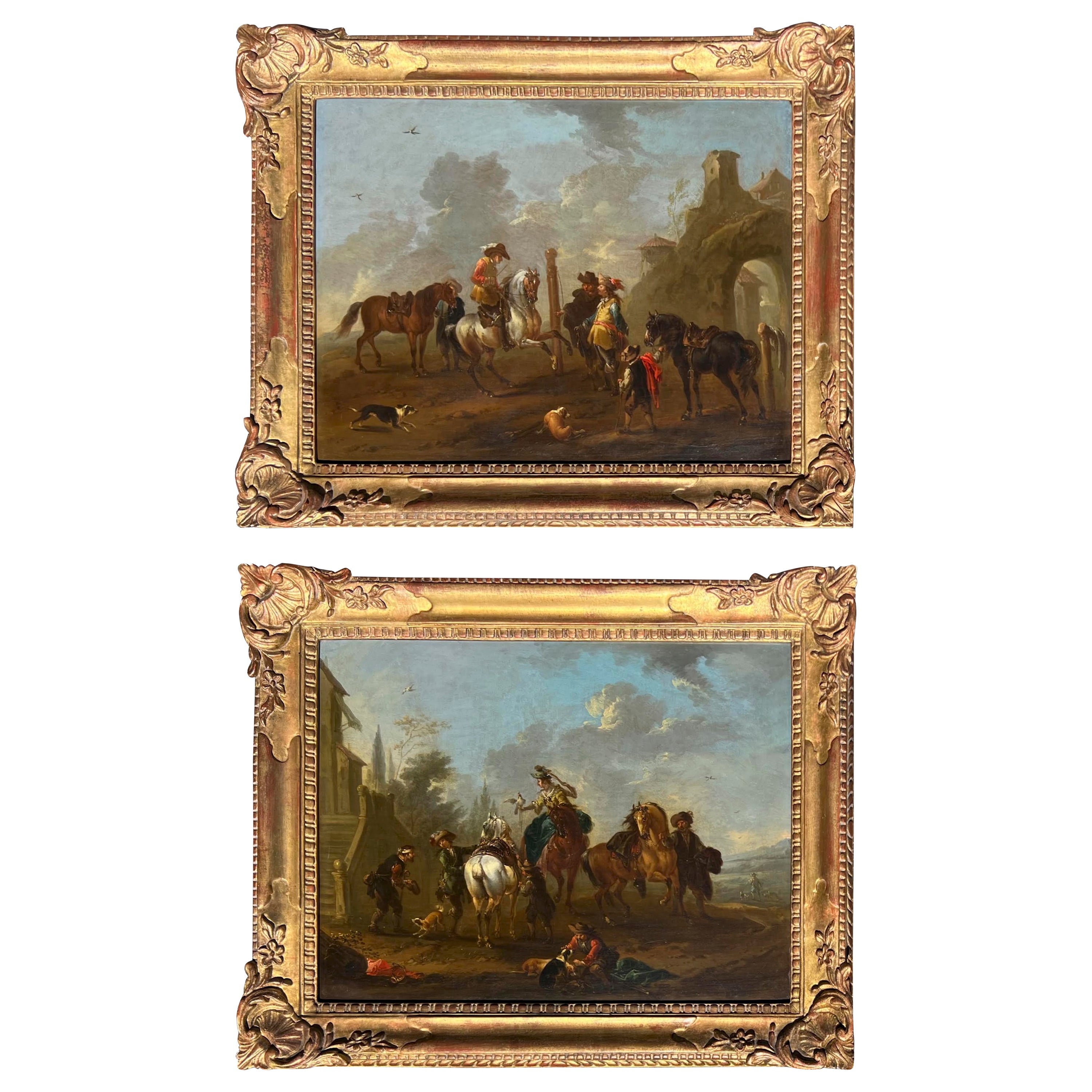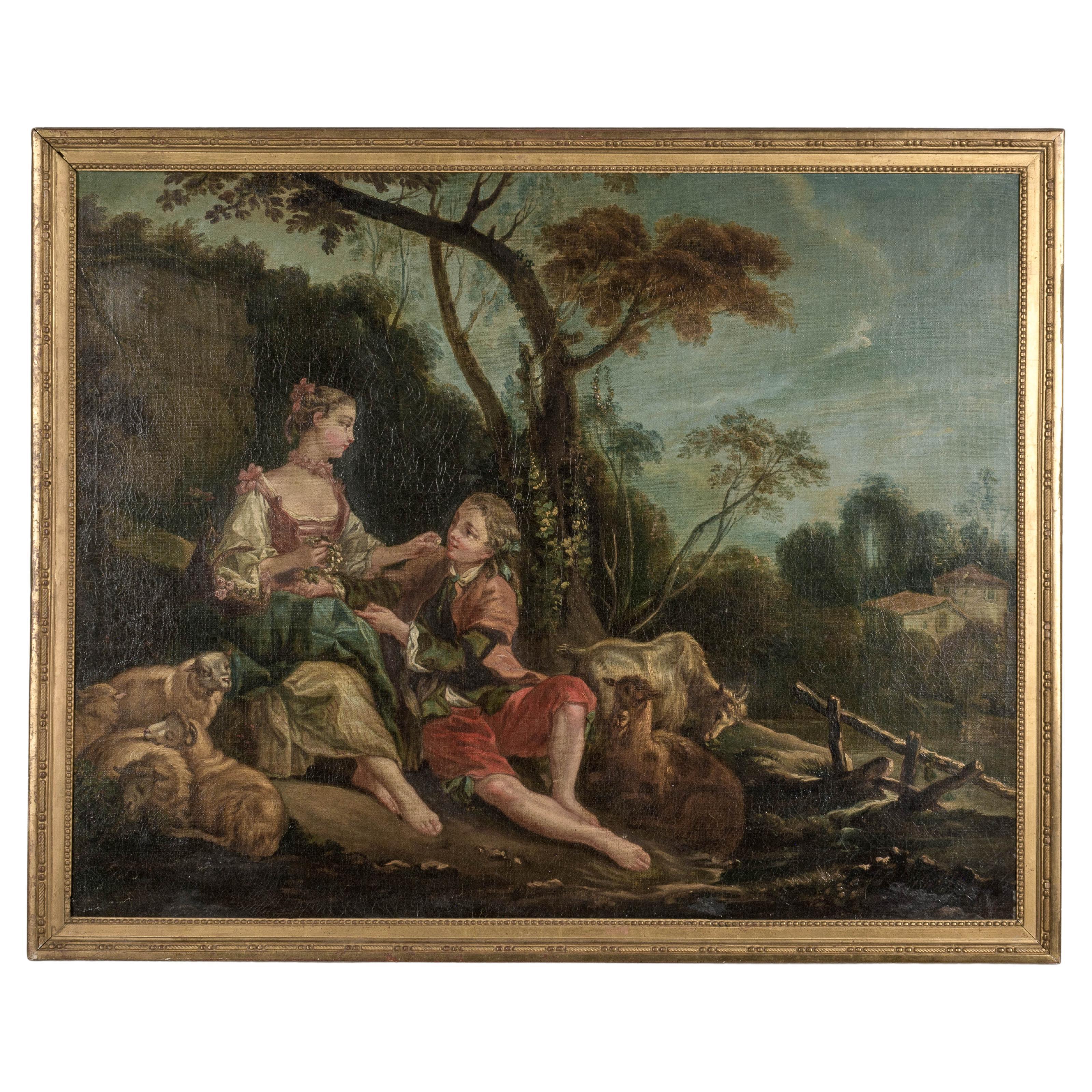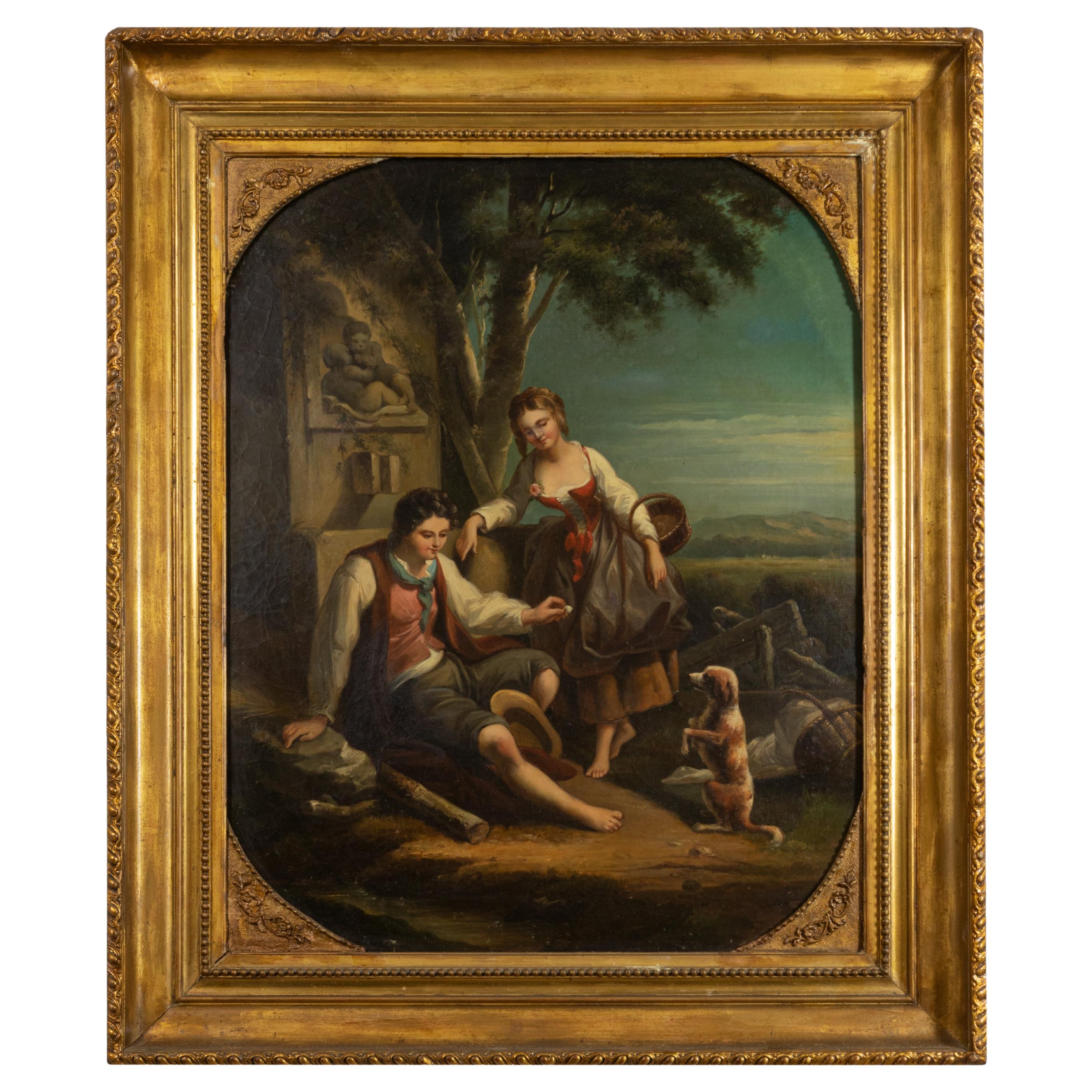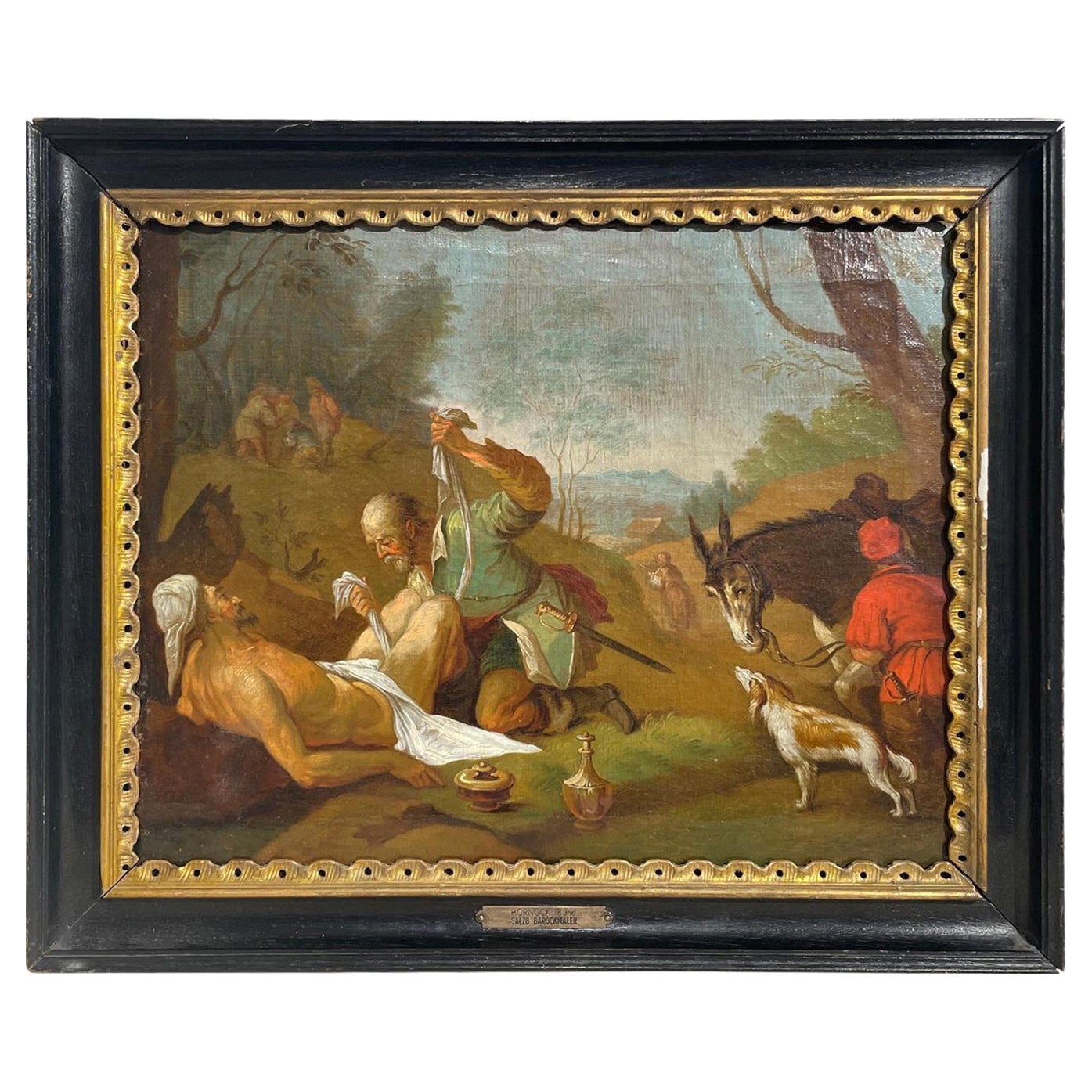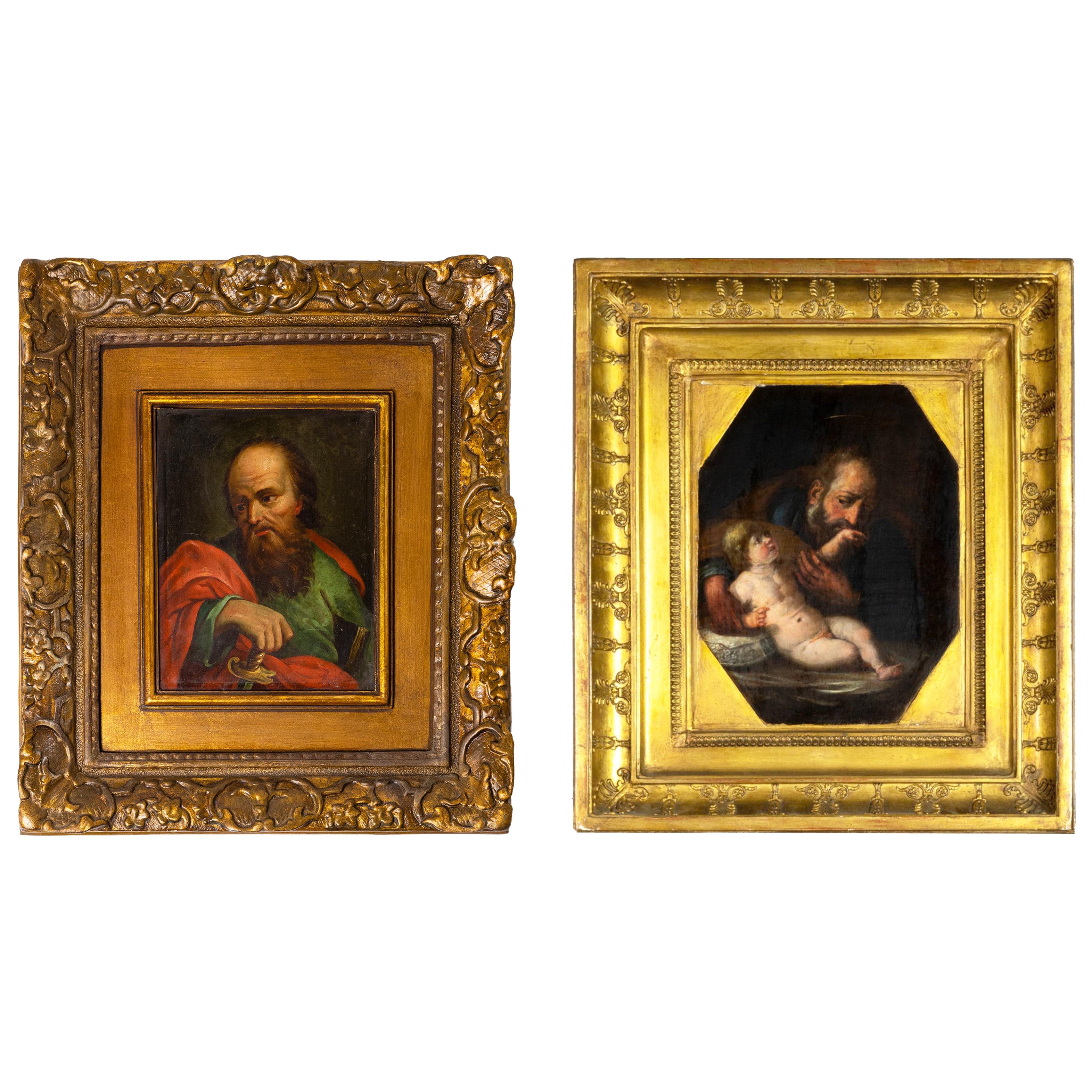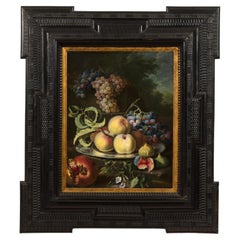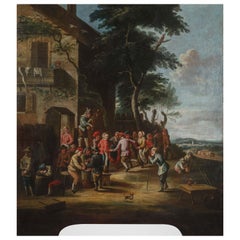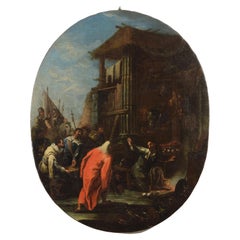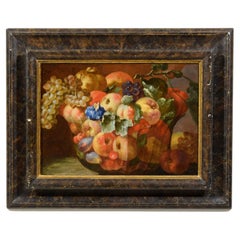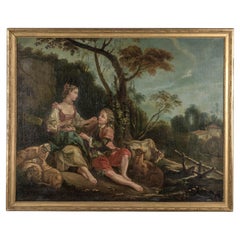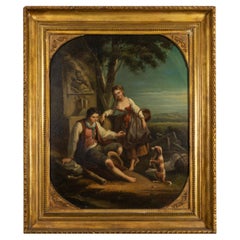Items Similar to 18th Century, Baroque Austran Painting by August Querfurt
Want more images or videos?
Request additional images or videos from the seller
1 of 15
18th Century, Baroque Austran Painting by August Querfurt
About the Item
August Querfurt (1696, Wolfenbüttel - 1761, Vienna)
Farmers and villagers at the entrance of a village
Oil on panel , cm 38,5 x 51. frame 66 x 53,5 x 4,5 cm
The valuable painting, with a great chromatic impact thanks to the technique of oil on board, depicts a lively scene of daily life in the countryside, set near the entrance door of a village. The episode of rural life, depicted with great vitality, through the use of quick touches of color and material, illustrates right, at the gates of the village, a cart loaded with hay and two farmers at work. Next to them sit some figures who stand beside their horses. A woman on her horse reaches a passer-by while behind a shepherd walks with his dog next to him. On the left, a child sits on his back while playing with dogs next to a horse, who is resting while sitting. The entrance to the village is characterized by an arched passage between ancient walls, described with poetic rovinism, as well as some houses. The clear sky is marked by some grey white clouds.
The work is signed with the letters A.Q. at the bottom right, recognizable in the monogram that Georg Kaspar Nagler indicates in his famous volume as belonging to the painter August Querfurt. His description informs us that the "Painter of battles of Wolfenbuttel (Germany), pupil of his father Tobias, painted in the style of Burgundy. In some of his works, which also depict hunting, are the initials of the name. He was stabbed at the hands of J. Burdé and A. Balzer. This master died in Vienna in 1761".
The stylistic comparison with the works signed and traced back by critics to Querfurt’s hand show similarities both in the artist’s characteristic technique, in the colour used and in the choice of subjects.
You can recognize some typical characters of the bambocciate of the master such as the drafting of color, with easy and fast brushstrokes proving to be skilled, through the highlights, in the yield of volumes and depths. The painter carefully describes the different protagonists, their gestures and clothing; attention that indicates a study from the truth of everyday life, read and interpreted with naturalism.
August Querfurt was born in Wolfenbuttel, Vienna in 1696 and is best known for his subjects depicting soldiers and battle scenes, certainly influenced by Philips Wouwerman’s painting.
Educated by his father, Tobias Querfurt, painter of landscapes and animals at the court of Brunswick, he later studied with Georg Philipp Rugendas (Augsburg 1666-1742) in Augsburg.
In 1752, Querfurt became a member of the Academy of Vienna. He had important commissions, as evidenced, among others, the twelve canvases, some large, made for Duke Charles Alexander of Württemberg and the eight paintings commissioned by Empress Maria Theresa depicting war events related to the War of the Austrian Succession (1740-1748). The works for the Empress are now housed in the Museum of Military History located in Vienna. Querfurt lived in a very turbulent period: the Holy Roman Empire, the Ottoman Empire, the Habsburgs, Great Britain and a number of other forces fought several battles near Vienna where Querfurt lived.
In the Austrian capital he died in 1761.
Some of his works are now exhibited at the Belvedere Palace in Vienna, at the National Gallery of Augsburg, others are in Berlin, Dresden, Stuttgart and Bratislava.
[… ]
In conclusion, the discovery of this work together with the recognition of the monogram, allows to add to the corpus of works of August Querturt a valuable testimony of his technical abilities and the confirmation that he was a talented painter of subjects different to the genre of battles to which in the past was exclusively traced.
We apologize for any translation errors. Please contact to have the expertise in Italian.
outlining more clearly the figure of the author.
- Dimensions:Height: 21.26 in (54 cm)Width: 25.99 in (66 cm)Depth: 1.97 in (5 cm)
- Style:Baroque (Of the Period)
- Materials and Techniques:
- Place of Origin:
- Period:
- Date of Manufacture:18th Century
- Condition:
- Seller Location:IT
- Reference Number:1stDibs: LU4405217793742
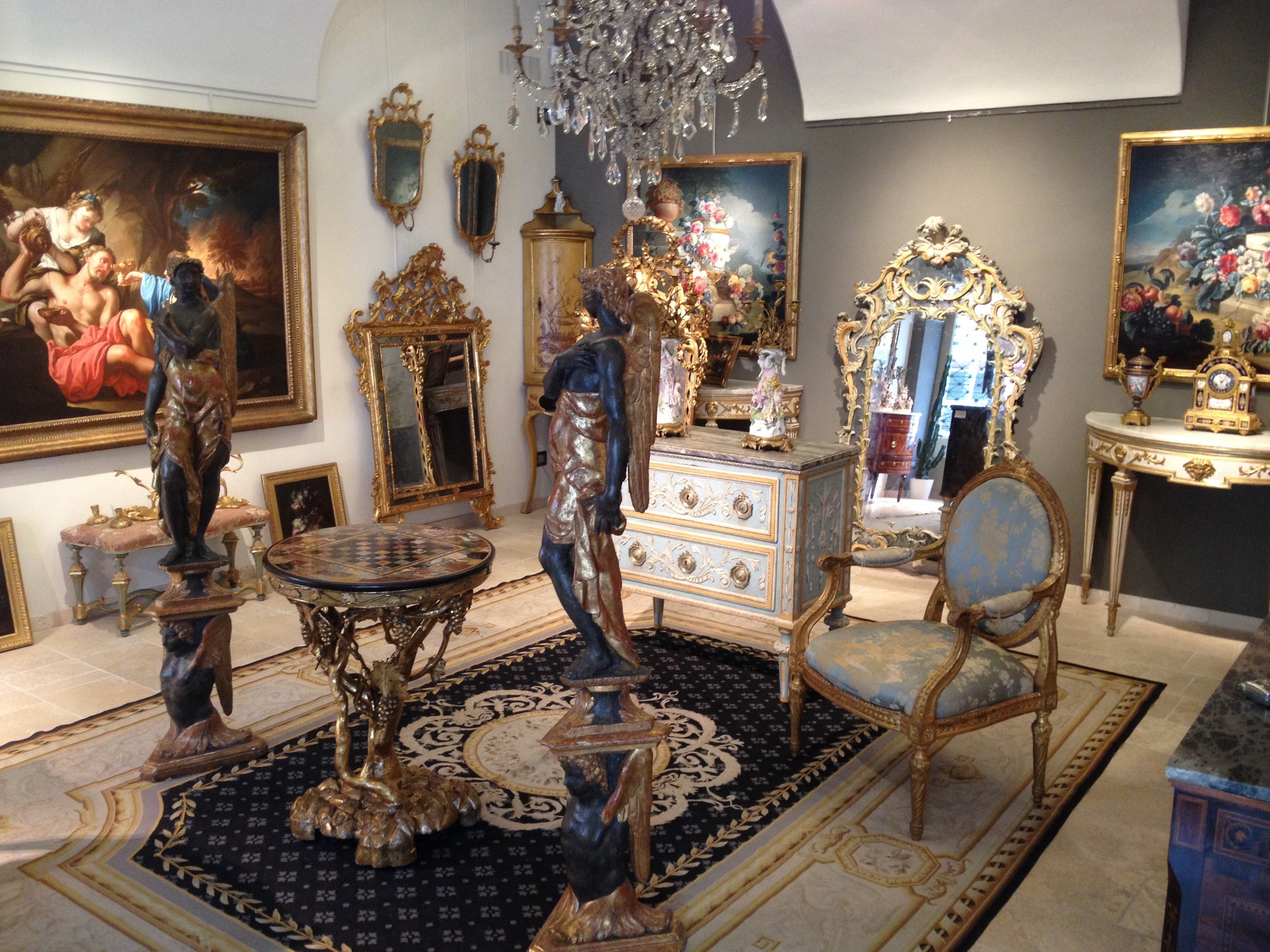
About the Seller
5.0
Platinum Seller
Premium sellers with a 4.7+ rating and 24-hour response times
Established in 1980
1stDibs seller since 2019
54 sales on 1stDibs
Typical response time: <1 hour
- ShippingRetrieving quote...Shipping from: Italy
- Return Policy
Authenticity Guarantee
In the unlikely event there’s an issue with an item’s authenticity, contact us within 1 year for a full refund. DetailsMoney-Back Guarantee
If your item is not as described, is damaged in transit, or does not arrive, contact us within 7 days for a full refund. Details24-Hour Cancellation
You have a 24-hour grace period in which to reconsider your purchase, with no questions asked.Vetted Professional Sellers
Our world-class sellers must adhere to strict standards for service and quality, maintaining the integrity of our listings.Price-Match Guarantee
If you find that a seller listed the same item for a lower price elsewhere, we’ll match it.Trusted Global Delivery
Our best-in-class carrier network provides specialized shipping options worldwide, including custom delivery.More From This Seller
View All18th Century, Painting with Still Life by Maximilian Pfeiler
Located in IT
Maximilian Pfeiler (active Rome, circa 1694-circa 1721 Budapest)
Still life with peaches, grapes, figs and pomegranate
Oil on canvas, Measures: cm H 63,5 x W 47. With frame cm ...
Category
Antique Early 18th Century Italian Baroque Paintings
Materials
Canvas, Wood
$24,075 Sale Price
20% Off
18th Century, Italian painting Depicts Bambocciata by Giovanni Michele Graneri
Located in IT
Giovanni Michele Graneri (Italy, Turin 1708-1762)
Bambocciata (Farmers dancing in front of the inn)
The painting, made in oil on canvas, depicts a moment of celebration where some p...
Category
Antique Mid-18th Century Italian Baroque Paintings
Materials
Canvas
$20,371 Sale Price
32% Off
18th Century, Italian Oval Painting by Pietro D Ollivero with Historical Subject
Located in IT
Painting by Pietro Domenico Ollivero.
"Manio Annio Curio Dentato receives the ambassadors of the Samnites", around 1740
The work in question depicts the scene of and was made by the famous italian painter Pietro Domenico Ollivero. The oval canvas shows on the back the card of the Galleria Caretto in Turin (Italy) with the authentic 1965 Giorgio Caretto. The work was also published in "I Piaceri e le grazie" by Arabella Cifani and Franco Monetti in 1993.
The subject refers to the history of Rome and an episode narrated by the historian Valerio Massimo.
Manius Curius Dentatus (330 BC - 270 BC), one of the great Romans of the 3rd century B.C. was a consul in ancient Rome, known for ending the Samnite Wars. Elected consul in 290 BC. along with Publio Cornelio Rufino, in the same year he fought and won the Third War against the Samnites and their allies, thus ending a conflict that had lasted for 49 years. He definitively subdued the Sabines and the Greek army of Pyrrhus in the battle of Benevento. He represented the ideal prototype of ancient Roman for the generations that followed in that he avoided public honours; Cato the censor, who collected his sayings, placed him among the great figures of universal history. For centuries after his death (in 270 B.C. while overseeing the construction of the second aqueduct in Rome) his military exploits were recounted and his moral rectitude was praised as an example for all the Romans. Ollivero, in the cultured choice of the episode, illustrates the moment when Manio Curio Dentato is found in his home, characterized by Roman walls, sitting by the fire, on a rustic bench while eating his meal in a "ligneo catillo" (wooden basin...
Category
Antique 1740s Italian Baroque Paintings
Materials
Canvas
$13,426 Sale Price
20% Off
18th Century, Italian Painting Still Life by Giovanni Paolo Castelli Lo Spadino
Located in IT
Giovanni Paolo Castelli, known as "Lo Spadino" (Rome 1659 – around 1730)
Still Life with a Composition of Fruit
Dimensions: frame cm L 76.5 x H 61 x D 6.5. Canvas cm L 55.5 x H 40
Th...
Category
Antique Early 18th Century Italian Baroque Paintings
Materials
Canvas, Wood
18th Century, Italian Pair of Oil on Canvas Paintings by Francesco Simonini
By SIMONINI
Located in IT
Francesco Simonini (Parma, 16 June 1686 - Parma, 1766)
“The rest of the soldiers” and “The march of soldiers”
oil on canvas
cm 40 x 58 and 40 x 60 ; frame: h 52,5 x W 70,5 x D 6 an...
Category
Antique Early 18th Century Italian Baroque Paintings
Materials
Canvas
$27,084 Sale Price
35% Off
18th Century Italian Oil on Canvas Painting with Battle by Antonio Calza
By Antonio Calza
Located in IT
Antonio Calza (Italy, Verona, 1653-18th April 1725)
"Battle between Christian and Turkish cavalry with castle"
The painting depicts a bloody battle between Christian and Turkish cavalry. Characterized by dynamism, intensity of color and light, the main scene occupies the lower horizontal section of the canvas, optically interrupted by the black fumes of the shots from which emerge, on the left, the towers of a fortress. On the right, in the distance you can see the combat in progress in the countryside, beyond which you can see the pale presence of hills that create a fifth, marking the horizon. To frame the scene contributes to the left, against light and in the foreground, a portion of the wall. The painter, however, introduces a horse on the ground, of which we see only the back, a ruse to involve the observer making him become active and participate in the scene. In the foreground, lifeless bodies, wounded horses and, scattered on the ground, weapons and a drum enhance the drama of the clash.
The excitement and expressive force, the intense chromatic range attentive to the conditions of light and the fine brushstrokes, decisive and dramatic, suggests the attribution to Antonio Calza, one of the most important painters of battles of the seventeenth century, excellent student and continuator of the greatest interpreter of the genre, Jacques Courtois called il Borgognone (Saint-Hyppolite 1621 - Rome 1676). Il Borgognone, although not having had a real school or direct students, places itself as a primary reference point by the Italian and foreign "battaglisti".
The genre of battle painting found great success in the collections of the Italian and European nobility of the seventeenth and eighteenth centuries. The battles of the Italian Renaissance, in which the scene converged towards a precise protagonist, evolve towards a type of combat "without hero". The bloody realism of the details and the dynamic development of the narrative confuse the figure of the protagonist, when present, to give importance to the swirl of horses and armed fighters, among which, moreover, does not emerge a winner.
The certain documents relating to the life and movements of Antonio Calza are scarce; it was equally difficult to reconstruct, from the critics, a catalogue of autograph works. Through paintings in private collections, in museums and paintings passed on the antiques market it has been possible to identify a copious corpus of works that can be traced back to his hand. The work of art historians, together with that of antique dealers, in conferring proper attributions in order to best outline the figure of Calza, continues but studies are still in progress. In this sense, the work of Giancarlo Sestieri should certainly be noted, who investigated the artistic production of the battaglisti and Calza, thus allowing the comparison of the numerous photographic works reported, to identify and recognize the stylistic qualities that distinguish the corpus of paintings assigned to him today.
Antonio Calza was born in 1653 in Italy, in Verona and in 1664 he entered the school of Carlo Cignani in Bologna, dedicating himself to painting battles and landscapes. He then perfected in Rome, where he knew the works of the then undisputed head of the sector, Jacques Courtois called the Burgundian. In 1675 he returned to Verona and married an 88-year-old widow who, dying, left him a rich inheritance. Much appreciated by the nobility and the bourgeoisie, he received numerous commissions. Bartolomeo Dal Pozzo (Le Vite de' pittori, de gli scultori et architetti veronesi, 1718) praises "three great paintings of battles...
Category
Antique Late 17th Century Italian Baroque Paintings
Materials
Canvas
$31,482 Sale Price
20% Off
You May Also Like
"An Elegant Hawking Party" A Pair of Paintings by August Querfurt
Located in Wiscasset, ME
Pair of old master paintings by August Querfurt (1696-1761). Oil on panel, one signed with initials in the lower left. Two scenes depicting hawking parties from the 18th century. ...
Category
Antique 18th Century Austrian Baroque Paintings
Materials
Paint
18th Century French Baroque Oil Painting
Located in Winter Park, FL
A late 18th century French painting depicting a romantic couple in a pastoral setting. Oil on canvas. Unsigned. Original gilded wood frame. Small repair to canvas in the upper left c...
Category
Antique Late 18th Century French Baroque Paintings
Materials
Giltwood, Paint, Canvas
Saint Joseph Jesus Baroque Painting, 18th Century
Located in Lisbon, PT
A 1700`s painting of Joseph with the Child Jesus on his lap, a rare Baroque motif of paternal love.
Oil on wood
Frame: 47x54 cm
Without frame: 27x34 cm
Category
Antique 18th Century Italian Baroque Paintings
Materials
Wood
Baroque Painting, Loving Couple, Watteau School, 18th Century
Located in Lisbon, PT
This signed 18th Century painting showcases a beautiful scene of a loving man and woman and their loyal canine companion gathered around a charming fountain, executed in the Baroque ...
Category
Antique 18th Century French Baroque Paintings
Materials
Canvas
18th Century Austrian Baroque Oil on Canvas Painting by Franz Xaver Hornöck
By Franz Xaver Hornöck
Located in West Palm Beach, FL
A light-brown, green antique Austrian Baroque oil on canvas painting by Franz Xaver Hornöck in a hand crafted original black, partly gilded wooden frame, in good condition. The vinta...
Category
Antique 18th Century Austrian Baroque Decorative Art
Materials
Canvas, Wood
Set Of 2 Baroque Paintings Of Joseph And Paul, 18th Century
Located in Lisbon, PT
A set of two Baroque paintings:
- A Saint Paul of Tarsus Painting, also called Apostle Paul, Saul of Tarsus, Saint Paul the Apostle or Apostle of the Gentiles.
The sword in Saint P...
Category
Antique 18th Century Italian Baroque Paintings
Materials
Copper
